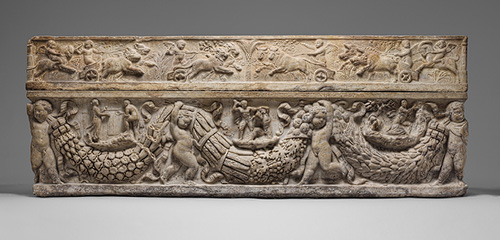According to Greek mythology, Ariadne was the daughter of Minos, king of Crete, and his wife Pasiphae. Minos was charged by Poseidon to care for a dangerous Minotaur in a labyrinth and offer it human, Athenian sacrifices every nine years. On the third cycle of sacrifices, Athenian prince Theseus volunteered to go with the sacrifices and slay the beast. Upon meeting the Athenian hero, Ariadne fell in love and devised a plan to help Theseus escape from the labyrinth and the hybrid creature. She secured a string between herself and Theseus so that he may kill the Minotaur and safely find his way out of the labyrinth. The plan was successful, and the two lovers escaped to the island of Náxos. Ariadne soon fell out of favor with Theseus, and the Athenian abandoned the Cretan princess on the island. She was eventually rescued by and married the god Dionysus. He raised her as an immortal, the goddess of vegetation, and placed her marital crown in the sky as a constellation (Encyclopedia Britannica Online, 1).
The long, oral tradition of the myth of Ariadne was written down in Ovid’s Metamorphoses in the first century CE. This epic poem documents the lives of gods and goddesses from Greek mythology, particularly in relation to change and love. In the book regarding Ariadne, Ovid charts the rapid peaks and plummets of love between Ariadne and her suitors (Ovid, 384-385). This consistent motion, further reflected in the cyclic movement of her constellation, is a concept important to ancient Grecians, particularly in relation to the seasons and associated vegetation. The ancient Greeks relied on the cyclic patterns of vegetation for their food source. This mythological tradition of Ariadne supported this idea and allowed for a physical representation that they could worship to ensure a successful harvest (Webster, 22).

The Marble Sarcophagus with Garlands and the Myth of Theseus and Ariadne is an ancient example of an object containing imagery of Ariadne. This object, discovered in 1889 near Rome, is a marble sarcophagus intended to hold human remains. This Greek myth would have been popular among the Romans due to the popularity of Ovid’s epic poem and its subsequent influence on Roman culture. The imagery on this object depicts both the attributions of Ariadne as a goddess of vegetation as well as the myth surrounding her and Theseus. The concept of vegetation goddess is evident in the sarcophagus through the flora, erotes, and animals. Depicted in shallow relief on the lid, four winged erotes drive chariots pulled by a bear, lion, bull, and boars. These beasts are associated respectively with spring, summer, fall, and winter. On the front of the piece, swaths of garlands featuring wheat, flowers, and fruits further represent the idea of vegetation associated with the Greek goddess. This series of vegetation-related imagery bolsters the idea of the ancient Greek and Roman dependence on a deity for their seasonal harvests. Further adding to the relief imagery on the sarcophagus, three installments of the myth’s narrative are positioned between the draping garlands. They represent Ariadne assisting Theseus with the string, Theseus slaying the Minotaur, and Ariadne abandoned on Náxos awaiting Dionysus (“Marble sarcophagus,” 1). This representation of a Greek myth on a roman sarcophagus denotes the culture’s interest in the literature produced by Ovid.
Julia Stewart
Works Cited
Encyclopædia Britannica Online, s. v. “Ariadne”, accessed March
05, 2015. http://www.britannica.com/EBchecked/topics/
34105/Ariadne.
“Marble sarcophagus with garlands and the myth of Theseus and
Ariadne [Roman, Hadrianic or early Antonine]” (90.12a,b) In
Heilbrunn Timeline of Art History. New York: The Metropolitan
Museum of Art, 2000-.http://www.metmuseum.org/toah/
works-of-art/90.12a,b. (August 2009).
Ovid. The Metamorphoses. Translated by AS Kline. Luxembourg:
Poetry in Translation, 2000.
Webster, TBL. “The Myth of Ariadne from Homer to Catullus.”
Greece & Rome 13, no. 1 (1996): 22-31.
